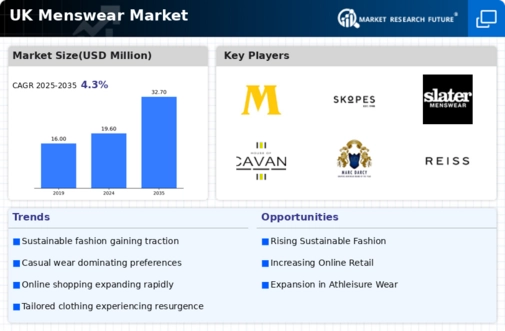Evolving industry dynamics, technological advancement, and altering consumer preferences
The men's wear market in the United Kingdom is currently experiencing a significant period of change marked by evolving industry dynamics, technological advancements, and altering consumer preferences. A pervasive pattern that comprises these transformations is the increasing desire for fashion that is both sustainable and ethical. This phenomenon is indicative of a more extensive societal transition towards social responsibility, environmental awareness, and transparency within the fashion sector.
As consumer consciousness regarding the ecological and societal consequences of their buying choices grows, they exhibit a preference for brands and products that demonstrate a commitment to sustainability and ethical conduct, by their values.
In addition, evolving consumer perspectives regarding ethical labor practices and social responsibility are propelling the demand for sustainable and ethical fashion in the men's wear market of the United Kingdom. As consumer awareness regarding labor rights violations and deplorable working conditions in the worldwide fashion supply chain grows, there is a growing expectation for brands to exhibit enhanced transparency and accountability concerning their sourcing and manufacturing procedures. Socially conscious consumers are drawn to brands that prioritize ethical treatment of workers, equitable wages, and safe working conditions. Such consumers are inclined to support companies that demonstrate a commitment to ethical principles.
Furthermore, in the men's wear market in the United Kingdom, technological advancements are significantly influencing the adoption of sustainable and ethical practices and fostering innovation. As an illustration, progress in textile recycling technologies empowers brands to repurpose and recycle post-consumer refuse into novel fabrics, thereby mitigating waste and diminishing the necessity for virgin materials. In a similar vein, the implementation of digital instruments like blockchain technology is augmenting the transparency and traceability of supply chains, enabling consumers to authenticate the provenance and manufacturing procedures of apparel.
An additional noteworthy element of the progression towards ethical and sustainable fashion in the men's wear market of the United Kingdom is the emergence of circular fashion models and initiatives that advocate for clothing repair, recycling, and reuse. To reduce their environmental impact and prolong the lifecycle of their products, brands are investigating novel business models including apparel rental, subscription services, and resale platforms. In addition, consumer education and awareness initiatives and campaigns are encouraging consumers to make more sustainable decisions and increasing public consciousness regarding the significance of responsible consumption.



















